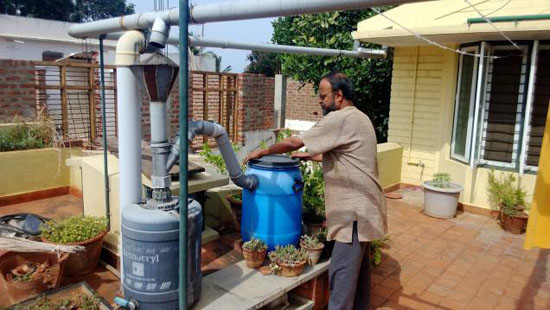As the storage levels at the Krishnaraja Sagar and Kabini reservoirs deplete, there is renewed interest in the concept of rainwater harvesting and conservation among residents.
While Mysore receives 800 mm of rainfall annually, a 200 sq. ft rooftop can harvest 15,000 litres of water every year. A family with five or six members requires 10,000 litres of water on an average for household purposes, which can be met through rainwater harvesting alone.
Again, if every house in Mysore and Bangalore had a rainwater harvesting (RWH) system installed, dependence on the Cauvery could be minimised for three to four months during the monsoon, thus reducing the pressure on the river. This will also ensure availability of water in the reservoir for a longer duration.
While the district tries to tackle the water crisis, there is a longstanding votary of rainwater harvesting system in Mysore who has single-handedly ploughed a lonely furrow for more than 20 years and in the process won many converts.
Meet U.N. Ravikumar, a renowned environmentalist known in the conservation circles for articulating on water issues and a strong proponent of alternative and low-cost sustainable technology.
Among the first who experimented with the RWH systems in Mysore when concepts of environment and conservation had not yet entered the mainstream public discourse, Mr. Ravikumar not only designed and installed RWH but also encouraged industries and households to take it up in a big way.
He says: “Once the RWH system is installed, one has to clean the roof before the first spell of rain, divert 50 litres of water as run off because they contain impurities and thereafter divert the harvested water on the rooftop through a basic sand filter, which will give you purified water. This can be stored in tank and used for primary use.”
He states that in Mysore, there are more than 5,000 houses and a few big industries with RWH systems and their dependence on the Cauvery is less compared to others.
In Mysore, many houses and a few major industries have withstood the brunt of the present crisis better.
While the present crisis shows lack of preparedness of the State, the pressure on tankers and sinking new borewells also underlines the absence of ecological concerns, says Mr. Ravikumar.
There is complete ignorance that availability of water in nature has remained constant or even declined while the population has grown.
Fifty per cent of fresh water is used for flushing in toilets and the precious resource is being criminally wasted, rued Mr. Ravikumar.
For RWH consultation, Mr. Ravikumar can be contacted on 0821 2544014.

